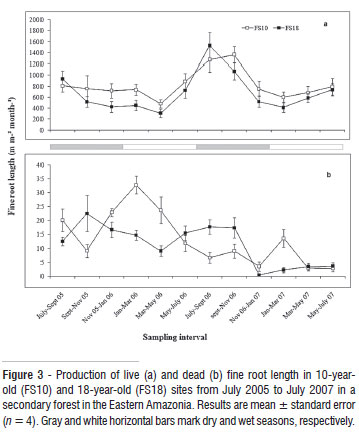The objective of this work was to assess the fine-root (≤ 2 mm diameter) production dynamics of two forest regrowths at different ages. Fine-root production was monitored by the ingrowth core method in one 18-year-old site (2 ha) and one 10-year-old site (0.5 ha), both localized in the Apeú region, Northern Pará State, Brazil. The sites were abandoned after successive shifting cultivation, beginning in 1940. Monthly production of live fine-root was similar between sites and was influenced by rainfall seasonality, with higher production during the dry season than the wet season for mass and length. However, mortality in terms of mass was higher in the 10-year-old site than in the 18-year-old site. The seasonality influenced mortality only in the 18-year old site following the pattern observed for live fine-root. The influence seasonal on mortality in terms of length was different between sites, with higher mortality during the wet season in the 10-year-old site and higher mortality during the dry season in the 18-year-old site. Specific root length was higher during the wet season and at the 10-year-old site. Fine-root production was not influenced by the chronosequence of the sites studied, probably fine-root production may have already stabilized in the sites or it depended more on climate and soil conditions. The production of fine-roots mass and length were indicators that generally showed the same pattern.
drought; root biomass; seasonality; succession; tropical forest






